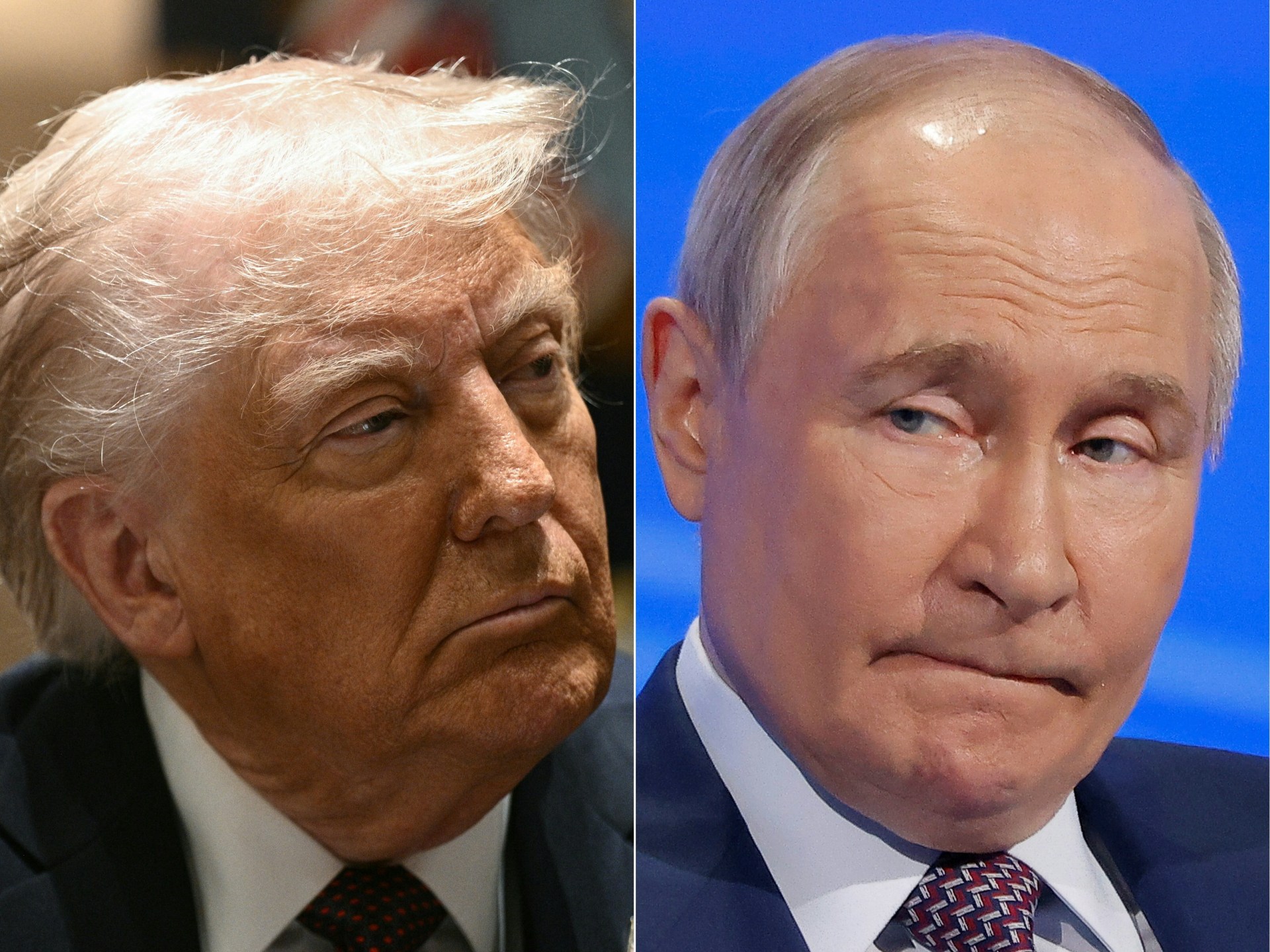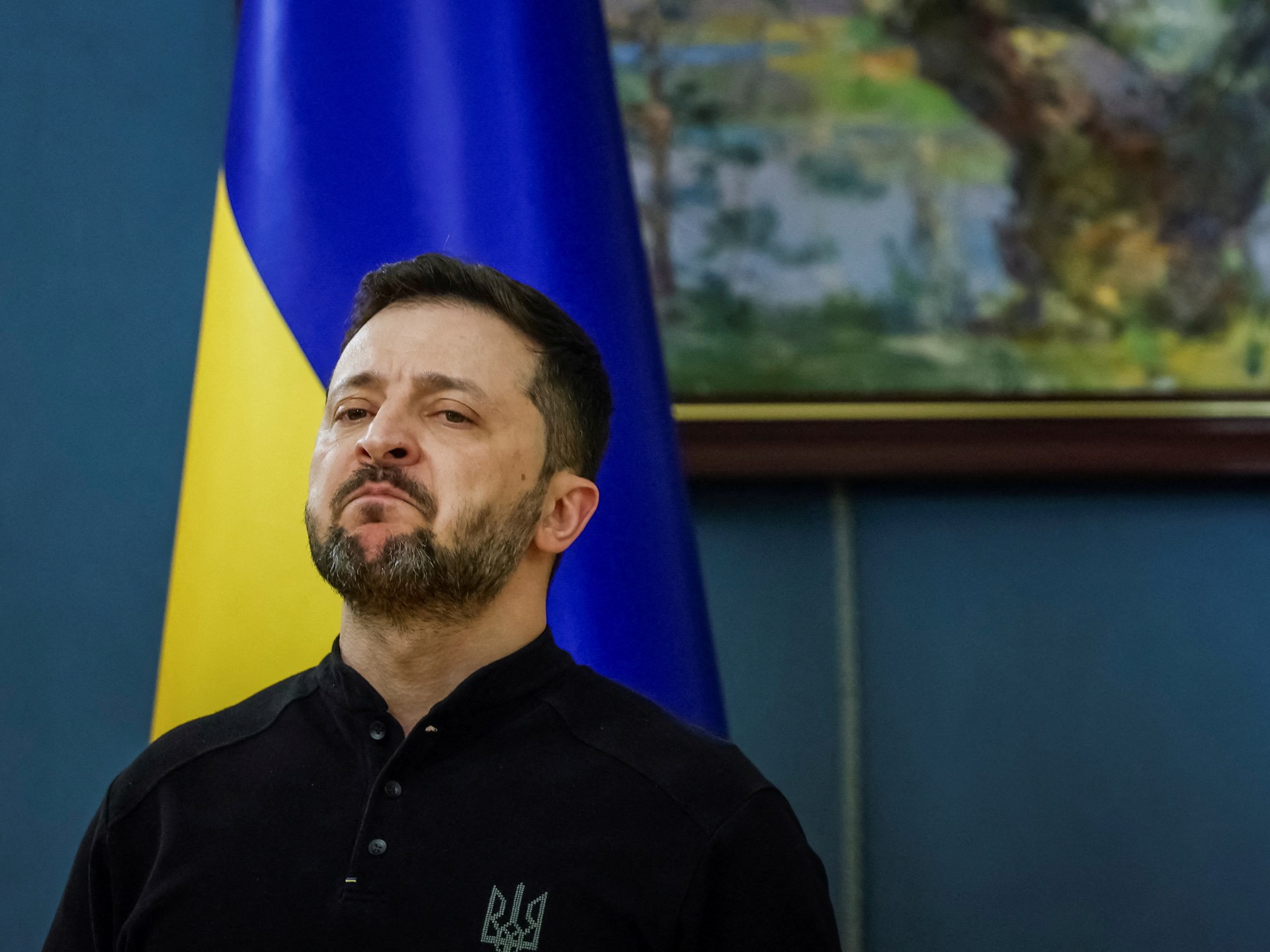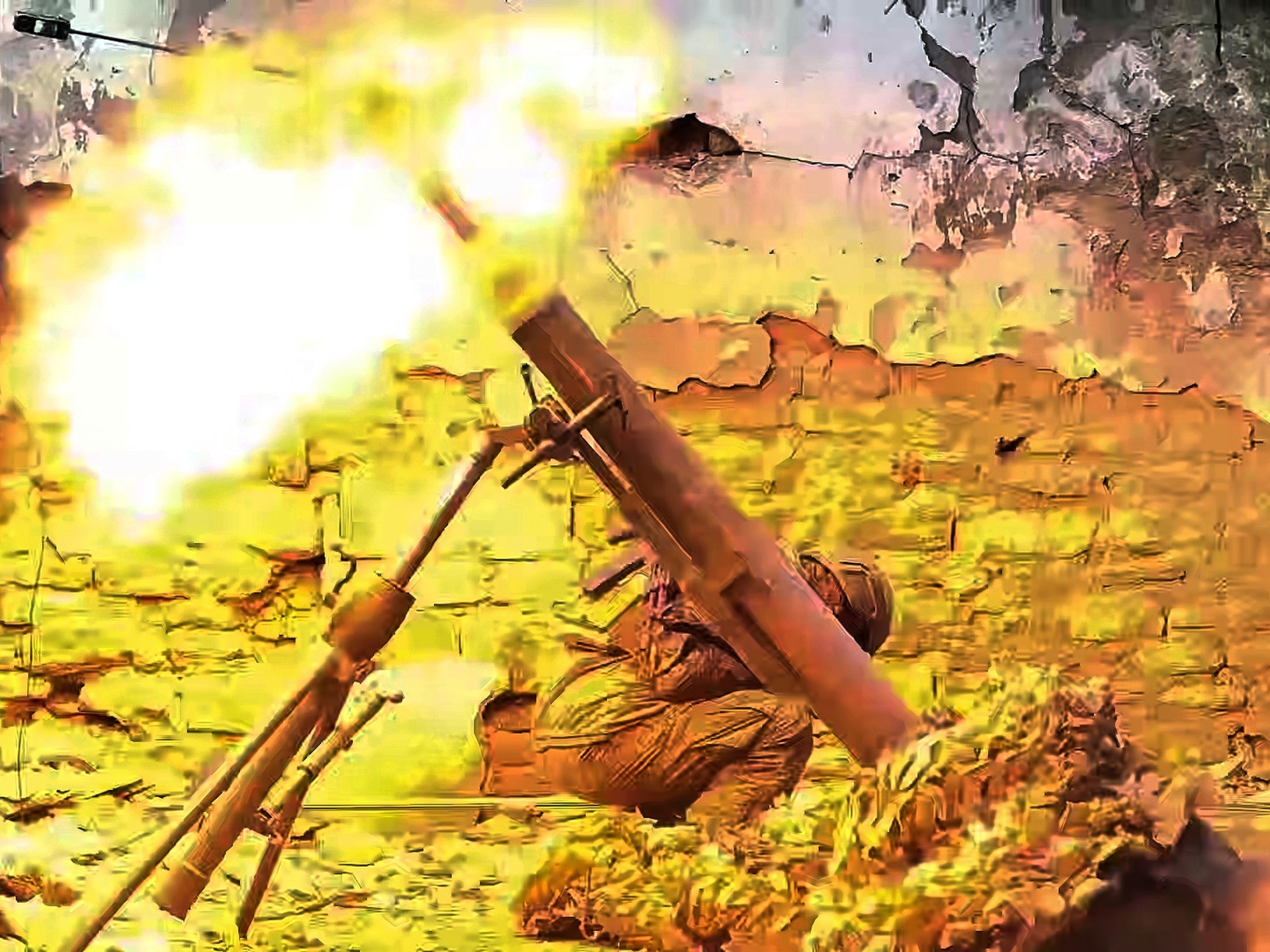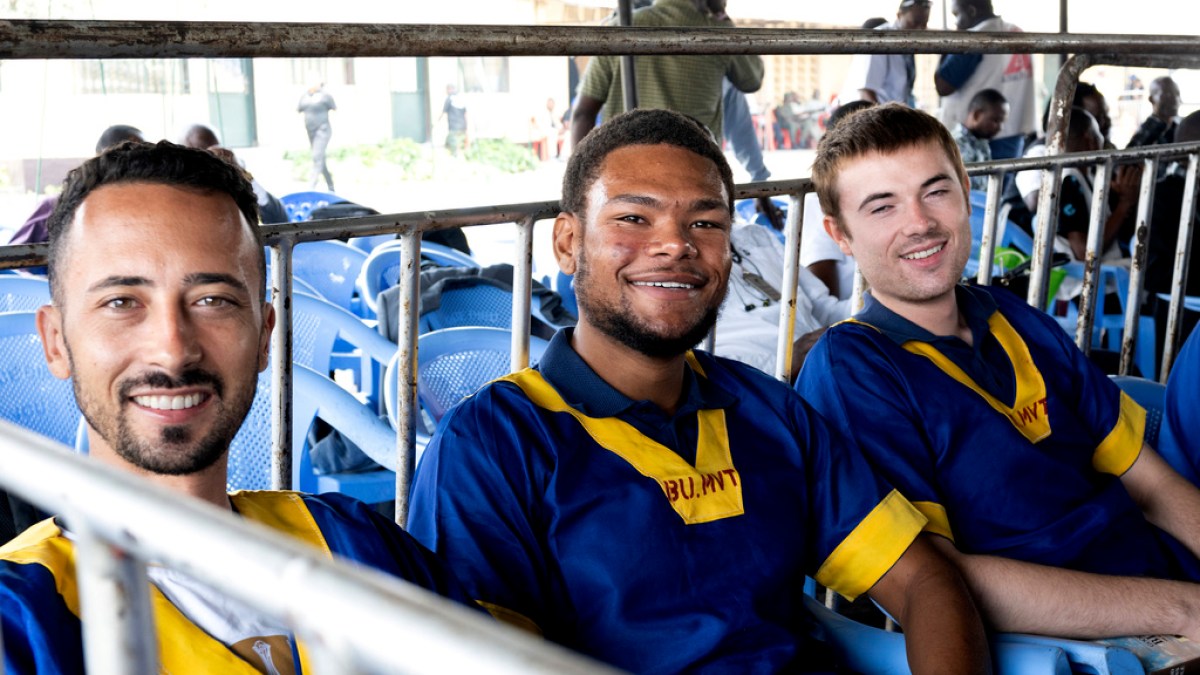Conflict Zones
Why is Trump ‘very angry’ with Putin and who will secondary tariffs hurt? | Donald Trump News

United States President Donald Trump said on Sunday that he was “p***** off” at his Russian counterpart, Vladimir Putin, and would slap additional financial penalties on the sale of Russian oil if he did not agree to a ceasefire in Ukraine.
The comments marked a sharp change in tone from Trump, who has been open to peace negotiations with Moscow since his second term began in January.
Here is more about what happened, what Trump’s threat could involve, and why this is significant for Putin’s war on Ukraine, and for countries that buy Russian oil.
What did Trump say about Putin?
During an interview with NBC on Sunday, Trump said he was “very angry” and “p***** off” over Putin questioning the legitimacy of Ukrainian President Volodymyr Zelenskyy.
Trump argued that any move seeking to replace Zelenskyy as the leader of Ukraine would inevitably delay the prospects of a ceasefire.
However, Trump did add that Putin knew he was angry with him. He said he and Putin had “a very good relationship” and “the anger dissipates quickly … if he does the right thing”.
What had Putin said about Zelenskyy?
Putin said Zelenskyy lacked the legitimacy to sign a peace agreement.
The Russian leader has frequently claimed that the Ukrainian government is illegitimate, ever since the 2014 overthrow of Moscow-leaning President Viktor Yanukovych, whom the Kremlin claims had US backing.
Putin suggested on Thursday that a temporary administration be established in Ukraine under the supervision of the United Nations. This proposal was rejected by UN Secretary-General Antonio Guterres.
Zelenskyy was sworn in as the president of Ukraine in 2019 for a five-year term. The war broke out following Russia’s full-scale invasion of Ukraine in February 2022. While Ukraine was supposed to have presidential elections in 2024, the country has been under martial law due to the war, and its constitution does not allow it to hold elections under martial law conditions.
Though Trump has now criticised Putin for questioning Zelenskyy’s legitimacy as Ukraine’s president, the American leader did the same not long ago.
In February, amid tensions with the Ukrainian leader, Trump described Zelenskyy as “A Dictator without Elections” in a post on his Truth Social platform.
What is the state of diplomatic efforts to end the Ukraine war?
During his presidential election campaign, Trump promised that he would bring the Ukraine war to a prompt halt.
Since his inauguration, US negotiating teams have separately met Russian and Ukrainian teams multiple times in Saudi Arabia to discuss peace terms. Trump has also separately spoken to Putin and Zelenskyy since then.
The three sides agreed on March 25 to stop using military force in the Black Sea. They also agreed to pause attacks on energy infrastructure in Russia and Ukraine for 30 days. However, both sides have accused each other of violating this and attacking energy facilities.
Ukraine and the US had agreed to a 30-day complete ceasefire on land and sea, which is pending Russia’s approval. Putin has not signed this proposal, citing reservations that Ukraine might use the period to rearm itself — including with supplies of cutting-edge Western weapons — and mobilise more soldiers at a time when it faces a manpower shortage.
What has Trump threatened — and will it work?
Trump has threatened “secondary tariffs” on Russian oil if he deems Moscow responsible for not reaching a ceasefire agreement.
“If Russia and I are unable to make a deal on stopping the bloodshed in Ukraine, and if I think it was Russia’s fault – which it might not be – but if I think it was Russia’s fault, I am going to put secondary tariffs on all oil coming out of Russia,” said Trump during the NBC interview.
“That would be that if you buy oil from Russia, you can’t do business in the United States. There will be a 25 percent tariff on all oil, a 25 to 50-point tariff on all oil.”
Keir Giles, a senior consulting fellow at the London-based Chatham House think tank, told Al Jazeera that it is unclear whether these threats would place pressure on Russia.
“We have seen sporadic threats by Trump to impose some kind of economic pressure on Russia but they never last long,” said Giles, adding it would be a “radical departure” from his past approach towards the war if Trump were to impose pressure on Moscow, rather than on Kyiv.
“We do not know if this threat is empty, but the previous ones have been, and Putin knows that,” Giles said.
What are secondary tariffs?
By “secondary tariffs” Trump appears to mean tariffs on imports from countries that buy Russian oil.
The US has long led campaigns of what are known as secondary sanctions — in which countries that trade with a sanctioned country also face sanctions. For instance, secondary sanctions are in place against the purchase of Iranian oil or heavy military equipment from Russia: countries, companies and individuals that engage in this trade are at risk of US sanctions.
The threat of secondary US sanctions is also why most global banks and financial institutions no longer participate in trade with Russia or Iran — they do not want to risk losing out on business in the US.
By contrast, secondary tariffs are relatively untested as a phenomenon. Last week, Trump also imposed a 25 percent secondary tariff on US imports from any country buying oil and gas from Venezuela.
Which countries could Trump’s secondary tariffs hurt?
If Trump imposes secondary tariffs on Russian oil, India and China could be hit particularly hard.
India and China are the two biggest buyers of inexpensive Russian crude.
Russian oil constituted 35 percent of India’s overall crude imports in 2024, while it made up 19 percent of China’s oil imports. Turkiye is also an importer of Russian oil — in 2023, as much as 58 percent of its refined petroleum imports came from Russia.
How much would secondary tariffs bleed China, India and Turkiye?
If Trump were to impose these tariffs, it is unclear whether they would be added to existing tariffs or if they would absorb other tariffs already in force.
The US is China’s single biggest export market. In 2024, China sold goods worth $463bn to the US. But Trump has already imposed 20 percent tariffs on all imports from China.
India too counts the US as its biggest export market. Indian exports to the US stood at $91bn in 2024. However, Trump has repeatedly railed against India’s high tariffs on US imports.
Turkiye is relatively less exposed. The US is its second-largest export market, after Germany, at $17bn in 2024.
However, Trump has threatened reciprocal, tit-for-tat tariffs from April 2 against all US trading partners.
And if Trump truly cracks down on countries that buy Russian oil, India in particular could find itself under Washington’s scrutiny. That is because India — which has 22 oil refineries, including the world’s largest in Jamnagar in the western state of Gujarat — has long been accused of buying subsidised Russian oil, refining it, and selling it to the West, effectively helping Moscow undercut Western sanctions.
In 2023, India exported $55.8bn worth of refined oil products such as petrol and diesel to countries including the US, the United Kingdom, France and Belgium that otherwise have strict sanctions on the import of Russian crude, according to data from the Observatory of Economic Complexity (OEC).
Following Canada, India is the second largest exporter of refined oil to the US, making up 7.5 percent of US oil exports as of 2023, OEC data shows.
But India has long argued that by buying Russian oil, it has freed up crude from other sources, such as the Middle East and Africa, for Western nations to buy, keeping global oil prices under control. If oil from Russia — a leading producer — were no longer available to anyone, every nation would need to scramble for limited supplies of crude from elsewhere, driving up prices.
Conflict Zones
Chinese soldiers in Ukraine: Is Beijing sending troops to back Russia? | Russia-Ukraine war News

Ukrainian President Volodymyr Zelenskyy said on Tuesday that his military had captured two Chinese men fighting with the Russian army.
Zelenskyy said that this was a clear sign that Russian President Vladimir Putin intended to continue the Ukraine war, potentially threatening the ongoing peace negotiations brokered by US President Donald Trump.
Ukrainian officials also said that the capture of Chinese soldiers – the first such instance in more than three years of the war – raised questions about Beijing’s commitment to peace. China has long insisted that it is a neutral party in the war and has pushed for a ceasefire, even as its relations with Russia have strengthened throughout the war.
Beijing has also, so far, avoided sending weapons and other military equipment for Russia to use in the war, while playing a key role in propping up the Russian economy, battered by unprecedented waves of Western sanctions.
So does the capture of Chinese soldiers in Ukraine, if confirmed, suggest that Beijing is now changing its policy and getting more directly involved in the war, including with manpower support for Russia?
What happened?
Zelenskyy posted on X, saying two Chinese citizens were captured by the Ukrainian military in Ukraine’s Donetsk region. Russia occupied parts of Donetsk alongside other Ukrainian provinces in 2022. Zelenskyy wrote that the army found identification documents, bank cards and “personal data” in the possession of the captured Chinese citizens.
“We have information suggesting that there are many more Chinese citizens in the occupier’s units than just these two,” Zelenskyy wrote. He added that Kyiv is continuing investigations into the matter and has contacted Beijing for a response. The captured men are currently in the custody of the Security Service of Ukraine, according to Zelenskyy.
“Russia’s involvement of China, along with other countries, whether directly or indirectly, in this war in Europe is a clear signal that Putin intends to do anything but end the war,” Zelenskyy wrote, adding, “This definitely requires a response. A response from the United States, Europe, and all those around the world who want peace.”
Ukrainian Minister of Foreign Affairs Andrii Sybiha said this casts a shadow of doubt on China’s formal position advocating for peace. “Chinese citizens fighting as part of Russia’s invasion army in Ukraine puts into question China’s declared stance for peace and undermines Beijing’s credibility as a responsible permanent member of the UN Security Council,” Sybiha wrote in an X post on Tuesday.
Our military has captured two Chinese citizens who were fighting as part of the Russian army. This happened on Ukrainian territory—in the Donetsk region. Identification documents, bank cards, and personal data were found in their possession.
We have information suggesting that… pic.twitter.com/ekBr6hCkQL
— Volodymyr Zelenskyy / Володимир Зеленський (@ZelenskyyUa) April 8, 2025
How has China responded?
China has denied Zelenskyy’s claims that several Chinese nationals are fighting in the war.
“Such claims have no basis. In fact, China’s position on Ukraine is very clear,” Chinese Foreign Ministry spokesperson Lin Jian told reporters in Beijing on Wednesday.
“Ukrainian side needs to view correctly China’s efforts and constructive role for the political settlement of the crisis.”
Are there past reports of Chinese soldiers fighting in Ukraine?
Yes, news outlets and social media posts have previously said that Chinese mercenaries are fighting in Ukraine.
French news outlet Le Monde reported on April 6 that it identified social media accounts of 40 Chinese people who claim to have signed up with Russian forces. The outlet interviewed a 37-year-old Chinese man who joined the war as a foreign mercenary in July 2023 and has since moved back to China.
In October 2024, there were reports on social media that Ukrainian forces had killed two Chinese mercenaries in Russia, the US-based Newsweek magazine reported. However, this was not backed by evidence and could not be independently verified by Newsweek.
Is China sending its soldiers to fight for Russia?
No, even if Zelenskyy is right and Chinese nationals are fighting in Ukraine on Russia’s behalf, that does not imply that Beijing has sent them there.
Mercenaries from multiple countries have arrived in Russia as tourists and joined the army in fighting against Ukraine. Several foreign mercenaries have also fought on Ukraine’s side against Russia in the war. And many foreign nationals have claimed over the past three years that they were duped into joining the Russian or Ukrainian militaries after being promised other jobs – a lucrative pay packet an incentive.
What other foreign fighters are involved in the Russia-Ukraine war?
In 2022, Putin supported a plan to allow foreign fighters to join Russia in the war. Many South Asian men, predominantly from Nepal, India and Sri Lanka, joined as mercenaries seeking economic opportunities.
While a Nepali Ministry of Foreign Affairs official estimated that about 200 Nepali men were fighting in Russia by the end of 2023, many estimate that there might be thousands of Nepalis on the battlefield.
In February, the Indian Ministry of External Affairs said that 127 Indian nationals were serving in the Russian armed forces. It is unclear how many among these Indian nationals are still fighting in Russia. According to the ministry last month, 16 Indian nationals who were serving in the Russian army have gone missing and the Indian government is in contact with the Russian government to find them.
South Korea, the US and Ukraine have also alleged that North Korean troops are fighting alongside Russian soldiers in Kursk amid strengthening military cooperation between Moscow and Pyongyang. Russia has not explicitly confirmed this. “But there is a difference: the North Koreans were fighting on the Kursk front against us,” Zelenskyy said on Tuesday during a combined briefing with Belgian Prime Minister Bart De Wever. “The Chinese are fighting on the territory of Ukraine,” said Zelenskyy.
Meanwhile, Colombia-based City Paper Bogota reported in November 2024 that more than 300 Colombian mercenaries fighting on Ukraine’s side had been killed during the war. Some Sri Lankans and Indians have also fought on Ukraine’s side.
Western nationals have also joined the war, fighting on the Ukrainian side. Many of these volunteer soldiers are US nationals. It is unknown how many US nationals are currently fighting in Ukraine. A CNN investigation published in January revealed that 20 Americans are missing in action in Ukraine, and casualties are spiking.
What is China’s stance on the Ukraine war?
China officially claims a neutral stance on the war. Beijing says it does not provide Russia or Ukraine with lethal assistance, unlike Western countries which have armed Kyiv with cutting-edge weapons.
“China welcomes all efforts aimed at promoting peace talks and supports the establishment of a balanced, effective, and sustainable European security framework to ultimately achieve lasting peace and stability in Europe,” Chinese Foreign Minister Wang Yi said in February.
However, China is a close political and economic ally of Russia and has continued to purchase discounted Russian oil, which has helped fund Moscow amid economic sanctions from the West.
Western companies withdrew business from Russia following Moscow’s full-scale invasion of Kyiv in February 2022. However, Chinese companies, including tech giants Alibaba and DiDi, continued business in Russia without scaling back. Chinese exports to Russia grew to fill the vacuum left behind by Western companies. In October 2024, Chinese exports to Russia grew by 12.7 percent compared with the previous year, Chinese customs data showed.
China has also backed Russia in United Nations resolutions on the war. In February, China abstained from voting on a UN General Assembly (UNGA) resolution which called for “advancing a comprehensive, just and lasting peace in Ukraine”. In February 2023, China abstained from voting on a UNGA resolution calling on Moscow to withdraw its troops from Ukraine. In April 2022, China voted against a UNGA resolution suspending Russia from the UN Human Rights Council.
What is the latest on Russia-Ukraine peace talks?
Since February, teams from Russia and Ukraine have separately met with representatives from the US for peace talks in Saudi Arabia. On March 25, the US and Russia announced a Black Sea deal where Russia agreed to halt the use of force and stop the military use of commercial vessels in the Black Sea. Ukraine agreed to these terms. All sides also agreed to a 30-day ceasefire on attacks on Russian and Ukrainian energy infrastructure.
However, Russia and Ukraine have since traded blame for violating the agreed terms so far. Putin also has not agreed to a 30-day complete ceasefire jointly greenlit by Washington and Kyiv.
On April 6, Zelenskyy posted on X, saying: “Today’s Russian attack included missiles launched from the waters of the Black Sea … A ceasefire at sea is not just about free navigation and the export of food products — it is, above all, about overall security and bringing peace closer.”
Conflict Zones
Russia-Ukraine war: List of key events, day 1,140 | Russia-Ukraine war News

Here is where things stand on Wednesday, 9 April:
Fighting
The Ministry of Defence in Moscow said its units intercepted and destroyed 23 Ukrainian drones overnight on the border in Russia’s Kursk and Belgorod regions.
The ministry also said Russian forces mounted a shock attack and recaptured the village of Guyevo in Kursk, which had been held by Ukrainian troops since August 2024.
Moscow said it carried out air and artillery strikes on Ukrainian troops inside Russian territory, pushing Kyiv’s soldiers back towards the border.
Ukrainian forces attacked two Russian energy facilities in the past 24 hours despite a mutually agreed moratorium on energy strikes, the Russian Defence Ministry also said.
Ukraine’s Air Force said Russia launched 46 drones and an Iskander-M ballistic missile during an overnight attack, of which nine drones were shot down and 31 were lost due to electronic warfare measures.
At least 17 people were injured in Russian drone attacks on the Ukrainian cities of Dnipro and Kharkiv, which also caused fires and damaged houses, regional authorities said. One woman was left in serious condition due to her injuries.
Ukraine said its forces struck and destroyed an aircraft hangar complex, several military buildings and technical equipment, killing about 30 Russian soldiers in Ozerki village, located in Russia’s border region of Kursk.
Ceasefire
United States Ambassador to the United Nations Dorothy Shea told the UN Security Council that Washington “will have no patience” for negotiations made in bad faith or violation of any commitments in efforts to end Russia’s war on Ukraine. “We will ultimately judge [Russian] President [Vladimir] Putin’s commitment to a ceasefire by Russia’s actions,” Shea said.
Politics and Diplomacy
Kremlin spokesperson Dmitry Peskov said it was very hard to imagine the start of negotiations with the US on a new nuclear arms reduction treaty due to the mutually strained trust with Washington, which was only on the mend.
Ukrainian President Volodymyr Zelenskyy said his troops engaged six Chinese soldiers fighting for Russia on the battlefield and detained two as prisoners of war. Zelenskyy said he had ordered officials to obtain an official explanation from China as to why Chinese nationals were fighting with Russian forces.
China’s charge d’affaires has been summoned over the presence of Chinese people fighting for Russia, Ukraine’s Minister of Foreign Affairs Andrii Sybiha said. “Chinese citizens fighting as part of Russia’s invasion army in Ukraine puts into question China’s declared stance for peace,” he said.

A new round of Russia-US consultations will take place on Thursday regarding the restoration of normal functioning of Russian and US embassies, the Reuters news agency reported citing a diplomatic source.
According to Russia’s state-owned news agency TASS, Moscow’s delegation at the normalisation talks will be led by the newly appointed Russian ambassador to the US, Alexandr Darchiev, while the US delegation will be headed by Deputy Assistant Secretary of State Sonata Coulter.
Aid
Belgian Prime Minister Bart De Wever said his government had decided to provide a 1 billion euro ($1.19bn) aid package to Ukraine this year. He also said his country planned to support Kyiv with a similar package each year during his term.
US Secretary of Defense Pete Hegseth will be virtually attending a meeting of the Ukraine Defence Contact Group (UDCG) on Friday, the AFP news agency reported, quoting a US defence official.
Conflict Zones
DR Congo repatriates three US citizens convicted over failed coup | Politics News

Move coincides with DRC’s drive to sign minerals deal with US in exchange for security in war with Rwanda-backed rebels.
Three United States citizens initially sentenced to death in the Democratic Republic of Congo (DRC) over a botched coup attempt have been repatriated after Kinshasa commuted their death sentences to life imprisonment last week.
Congolese presidential spokesperson Tina Salama said on Tuesday that the three men, including the son of political exile Christian Malanga, who led the attack on the presidential palace in May last year, would all serve out their life sentences in the US.
Marcel Malanga, 21, claimed he had been forced to take part by his father, who live-streamed from the palace during the coup attempt before being shot and killed by Congolese forces.
Also repatriated were Tyler Thompson Jr, 21, a friend of the younger Malanga, and Benjamin Reuben Zalman-Polun, 36, who reportedly got to know the father through a gold mining company.
US Department of State spokesperson Tammy Bruce confirmed the transfer on Tuesday, saying that the US condemned the armed attacks and supported DR Congo’s bid to hold the convicts accountable, but that it also sought “consistent, compassionate, humane treatment and a fair legal process”.
When the US assumes custody of prisoners convicted abroad, it typically agrees to carry out the sentence of imprisonment designated by that country.
Jared Genser, a US-based international human rights attorney, said that lawyers representing the three could try to get their sentences reduced by arguing they signed their consents to the prisoner transfer treaty under duress.
“But it would be very hard to prevail in such a case as there would be enormous implications for other potential transfers in the future if the US failed to abide by such agreements,” Genser said.
Multibillion-dollar deal
The repatriation came amid efforts by Congolese authorities to sign a minerals deal with the US in exchange for security support that will help Kinshasa fight Rwanda-backed M23 rebels in the country’s conflict-hit east.
US senior adviser for Africa Massad Boulos said last week that the countries were in talks on the issue, adding that it could involve “multibillion-dollar investments”. The US has estimated that Congo has trillions of dollars in mineral wealth.
Boulos, whose son is married to US President Donald Trump’s daughter, is set to visit DR Congo to discuss tensions between the country and Rwanda.
News of the trio’s repatriation brought joy to the families. Miranda Thompson, stepmother of Thompson, who had flown to Africa from Utah for what his family believed was a free vacation, said the family was “excited” to have him return home.
A total of 37 people were sentenced to death in the purported coup attempt, also including a Belgian, Briton and Canadian, all naturalised Congolese.
The fate of the others was not immediately clear.
Family members last year said the men slept on the floor at a high-security military prison in Kinshasa, struggling with health issues and having to pay for food and hygiene products.
-

 Sports1 day ago
Sports1 day agoMarch Madness: Florida wins the NCAA men’s basketball championship in a nail-biter over Houston
-

 Sports24 hours ago
Sports24 hours agoAntoine Griezmann: Why France and Atlético Madrid soccer star is always celebrating a hat-trick on April 8
-

 Africa1 day ago
Africa1 day agoTrump tariffs put 35,000 South African citrus jobs at risk, farmers warn
-
Middle East1 day ago
Are Iran and the US having ‘direct’ talks on the nuclear file? | Israel-Palestine conflict News
-

 Sports1 day ago
Sports1 day agoDodgers cap off 2024 World Series win with White House visit
-

 Europe1 day ago
Europe1 day agoLive updates: Trump news, China tariff war escalates, Supreme Court backs deportations
-

 Middle East1 day ago
Middle East1 day agoPenguins, vaccines: Can negotiations save Trump’s oddest tariff targets? | Donald Trump News
-

 Middle East1 day ago
Middle East1 day agoRecord global temperatures in March illustrate threat to climate goals | Climate Crisis News




